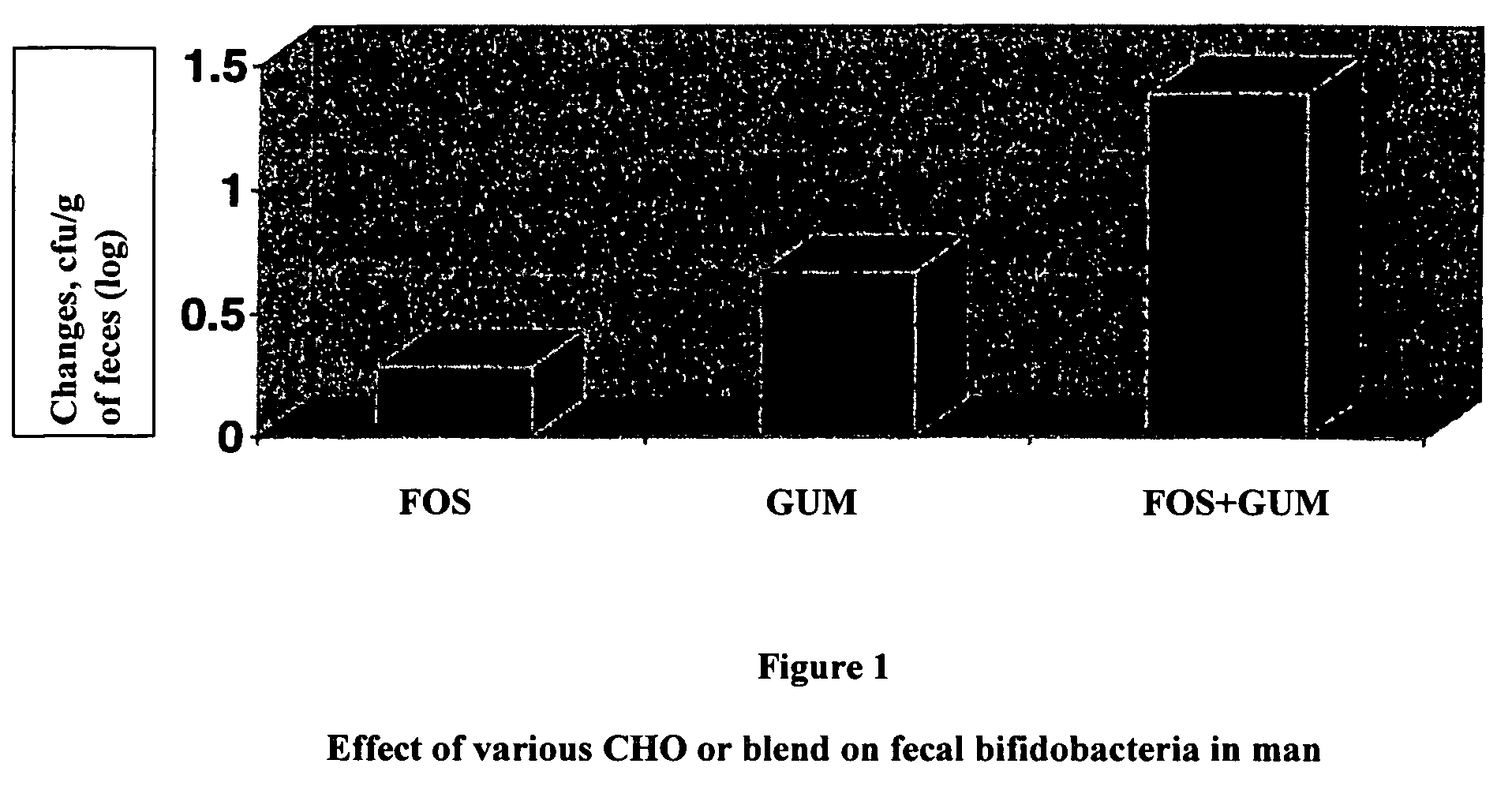Method of treating irritable bowel syndrome
a technology of irritable bowel syndrome and bowel disease, applied in the field of nutritional composition, can solve the problems of health damage caused by pathogenic bacteria, and achieve the effects of reducing side effects, promoting health benefits, and reducing cos
- Summary
- Abstract
- Description
- Claims
- Application Information
AI Technical Summary
Benefits of technology
Problems solved by technology
Method used
Image
Examples
example 1
[0037]A parallel design, consisting of 3 groups of 29 volunteers each, has been used:[0038]FOS: 6 g daily of (Raftilose P95N) during 6 weeks.[0039]XOS: 0.4 g daily of Xylo-oligo P95 during 6 weeks[0040]XOS FOS: 4 g daily of FOS and 0.2 g daily of XOS, during 6 weeks
[0041]Before the 6 weeks of treatment, a wash-out period of 3 weeks was observed. The participants were then followed-up during 5 additional weeks after the end of the treatment. During the wash-out and follow-up periods, the volunteers received a placebo.
[0042]During the complete test period, subjects refrained from eating fermented yogurts and products containing bifidus.
[0043]In general the test subjects showed an increase of bifidobacteria counts, particularly those who had a low initial value. The average and median increases were also calculated. A formal statistical analysis, shown below in Table I, gave the following results:
[0044]
TABLE 1Differences of bifidobacteria counts betweenstart and first week of treatment...
example 2
[0046]The trial was designed, according to the protocol, to compare three groups of 32 resp. 31 subjects in parallel:
[0047]FOS: 200 ml of skimmed milk with Raftilose P95®, 6 g per serving.
[0048]Fibergum: 200 ml of skimmed milk with Fibergum AS IRX®, 6 g per serving.
[0049]FOS+Fibergum: 200 ml of skimmed milk with Raftilose P95® (3 g per serving) and Fibergum TX® (3 g per serving).
[0050]Feces samples were tested 7, 21, 28, 49 and 71 days after the start of the study. The intervention period is between day 21 and 49. The change from day 21 to day 28 is of particular interest.
[0051]According to the protocol, a +1.35 log10 cfu / g of feces increase of Bifidobacteria after one week of treatment is expected for the FOS+Fibergum group.
[0052]The individual changes in the FOS+Fibergum group from day 21 to day 28 are summarized below:
[0053]
Min.1st Qu.Mean3rd Qu.Max.−0.330.071.3841.426.73
[0054]The differences were analyzed in two ways, first from a quantitative point of view, then more from a qua...
example 3
[0063]100 volunteers were assigned randomly to 4 diet groups, but stratified for their amount of native intestinal Bifidobacteria before the trial based on gender, age and average portions of fiber in the daily diet. The 4 diet groups are described below:
[0064]
ControlReference ProductFOS + GUMRaftilose ® 3 g and Fibergum 3.56 g per servingStarchResistant Starch 10 g per servingBlendRaftilose ® 3 g + Fibergum 3.56 g + Resistant Starch 10 gper serving
[0065]The primary analysis as to the outcome is the effect on the amount of Bifidobacteria in the feces. Counts of other micro-organisms were also analyzed. A further analysis was carried out to determine changes of abdominal sensation (flatulencies, quality and number of stools) as assessed by the volunteers, followed by an analysis of several short chain fatty acids measured in the feces.
[0066]The 100 volunteers were allocated to 4 groups as follows:
[0067]
Control:13 subjects (8 females, 5 males)FOS + GUM:29 subjects (19 females, 10 male...
PUM
| Property | Measurement | Unit |
|---|---|---|
| weight ratio | aaaaa | aaaaa |
| energy | aaaaa | aaaaa |
| nutritional composition | aaaaa | aaaaa |
Abstract
Description
Claims
Application Information
 Login to View More
Login to View More - R&D
- Intellectual Property
- Life Sciences
- Materials
- Tech Scout
- Unparalleled Data Quality
- Higher Quality Content
- 60% Fewer Hallucinations
Browse by: Latest US Patents, China's latest patents, Technical Efficacy Thesaurus, Application Domain, Technology Topic, Popular Technical Reports.
© 2025 PatSnap. All rights reserved.Legal|Privacy policy|Modern Slavery Act Transparency Statement|Sitemap|About US| Contact US: help@patsnap.com


